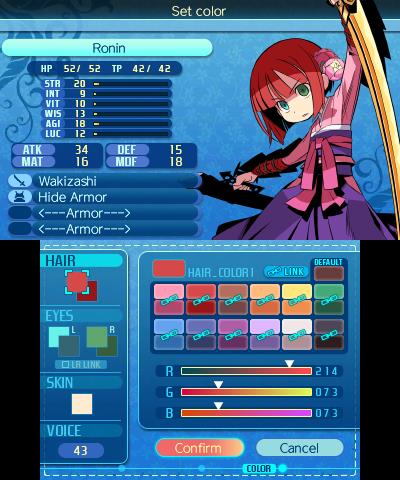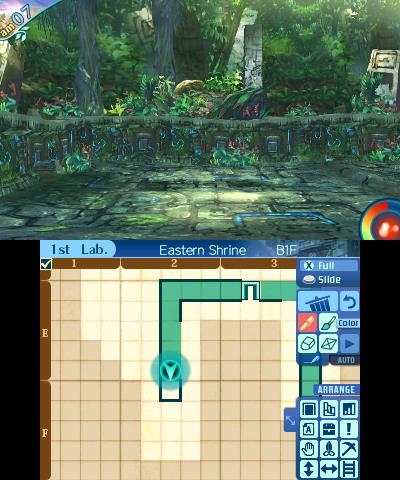Etrian Odyssey Nexus Impression
Atlus has done a fine job in designing a game accessible for newcomers with plenty to offer series veterans, or anyone looking for an excellent RPG challenge.
I’ve played each Etrian Odyssey entry upon western release and consider myself a big fan of the series. As such, I started Etrian Odyssey Nexus with a little lump in my throat and proceeded to equally split my first ten hours thinking “I remember that from Etrian Odyssey ___,” “Well, this is a new twist on the __________ mechanic,” and “*sob*, I’ll never experience a new version of Etrian Odyssey on a dual screen device again.” Adhering to the phrase if it ain’t broke, don’t fix it, Nexus takes the tried-and-true Etrian Odyssey formula and in at least its first two labyrinths does well with virtually all of its components: music, battles, interactions, and world-building.
Etrian Odyssey Nexus immediately lets players know that it takes place in the same world as the other releases in the series in the opening scene and doesn’t let go of the nostalgia factor all the way through the first two labyrinths. After hearing the setting is the Lost Islands of Lemuria, a land previously cut off from the rest of the Etrian Odyssey world, players are deposited in the airship city of Maginia. As in other Etrian Odyssey games, the menu-based home city consists of an inn for sleeping and saving one’s game, a shop for purchasing and upgrading equipment, a bar for accepting side quests, a guild hall for building the party, and a local government office where the main narrative is doled out.
The first task in Nexus is to create an adventure guild and fill it with up to one hundred player-created members. Eighteen returning classes from previous games and a brand new Hero class give an almost overwhelming variety of party build choices as players can only take five party members with them at a time. Once ready to begin the game proper, players will encounter NPCs from Etrian Odyssey III’s Armoroad on their way to take on enemies from Etrian Odyssey I in a dungeon ripped straight out of Etrian Odyssey IV. If players either haven’t played those titles or have not committed such information to long-term memory, gameplay is in no way negatively affected. The first labyrinth is a brand new creation that slowly explains all the necessary game mechanics to those that need it.
Aside from the town interactions and a brief overworld experience reminiscent of Etrian Mystery Dungeon where locations players are able to visit are clickable icons on a world map, the bulk of time in Nexus is spent in labyrinths. Navigating the labyrinths is purely a first-person dungeon-crawling affair, with beautifully-designed labyrinths on the top screen and a bottom screen that allows players to map out their path. The game offers dozens of options for players to color, annotate, or drop handy icons onto the map using the stylus. The 3D effects offered in this 3DS title provide an amazing depth of vision as players wander around colorful, unique labyrinths, each easily distinguishable from the others by design. The amount of attention given to the backgrounds of the labyrinths match the amazing character and monster designs, making Nexus a visual treat for players.
Battles in Nexus are mostly random encounters with the exception of a few exceptionally difficult-by-design monsters seen in the field and boss fights. A danger icon in the corner of the top screen slowly builds as players move, indicating when the random encounters are likely to take place. This is a great mechanic that lets players know how long they have to wander before needing to heal and be ready for a battle again. Battles in Nexus see five characters lined up in two rows to take on up to two rows of enemies. Besides fighting, defending, or using an item, technical points (TP) are available for characters to cast spells or use skills. This basic system is virtually unchanged from the original Etrian Odyssey, but it works well and has small tweaks that make it as polished a traditional turn-based RPG battle system as can been found in modern games.
Series music composer Yuzo Koshiro has done another wonderful job on the soundtrack for Nexus. While the music so far beautifully complements the easy pace of life in town, the sense of wonder while exploring, and the sense of excitement and danger during battles, a sound choice made for the localization by Atlus takes away from most of this. The previous three 3DS Etrian Odyssey releases have had English voice acting; Nexus does not. While it does have the option to turn off the Japanese voices, this also removes helpful hints characters often blurt out while walking through the labyrinth and during battles. English audio hints about secret passageways or enemies’ elemental weaknesses are simply not available to western players, a shameful omission for the pinnacle of the Etrian Odyssey series. A cringeworthy laugh by the tavern owner at the beginning and end of each side quest, of which there are plenty, was the final straw in the decision to mute voices for the upcoming remainder of the game.
There’s virtually no overarching narrative during the first ten hours of gameplay in Nexus, but this is not uncommon for most Etrian Odyssey games. The story typically starts as “go explore” and events in labyrinths eventually build the narrative over 60-100 hours of gameplay, so there’s plenty of time for Nexus to offer up more than what it has dribbled out so far.
I started Etrian Odyssey Nexus with a bittersweet lump of nostalgia in my throat, but that lump was quickly swallowed and turned into a stone in my stomach. Despite my experience with the series, I got punched hard during the early parts of the game, even on the second-lowest of four difficulty settings. Maybe I’ve grown a little soft from using wonderful DLC options that won’t be available until post-launch or more efficient party setups that players will inevitably flood message boards with next month, but so far, Nexus has me remembering my nearly blind, decade-old experience with the original Etrian Odyssey. Still, despite a half-dozen game overs, I’m thoroughly enjoying it. Similarly to how Dragon Quest XI provided numerous callbacks to multiple past games in its series while ever pushing the design forward, Nexus does the same for Etrian Odyssey. Its early stages indicate that Atlus has done a fine job in designing a game accessible for newcomers with plenty to offer series veterans, or anyone looking for an excellent RPG challenge.









Recent Comments